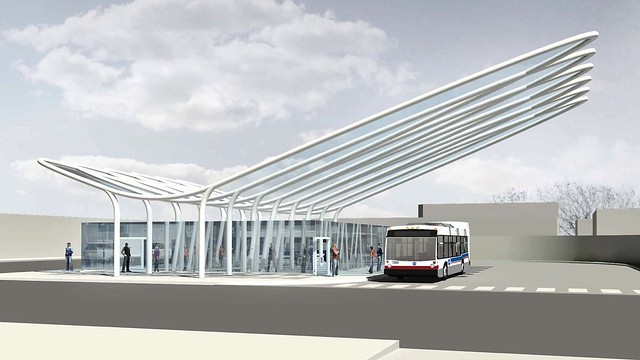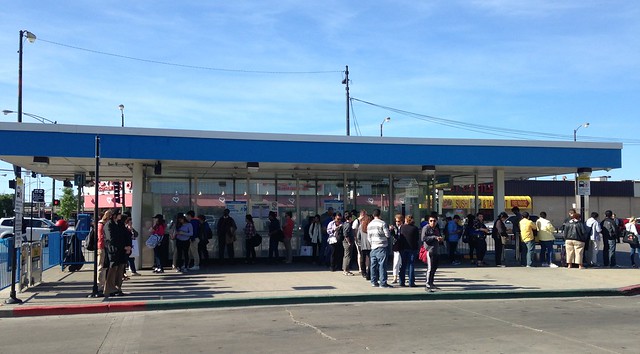Early this month the city announced upgrades the Blue Line’s Belmont stop that will cost up to $15 million. The improvements to the station, which opened in 1970 and was originally designed by Skidmore, Owings, & Merrill, include several cosmetic changes, including a space-age-looking weather canopy. However, many residents are scratching their heads about why the rehab won’t include the addition of elevators to make the stations compliant with the Americans With Disabilities act.
The project, which is slated to begin next year, is part of the CTA’s Your New Blue initiative, which includes makeovers to several stations along the Blue Line’s O’Hare branch, as well as track improvements. Residents have previously complained about the fact that many of the station redesigns don’t include elevators, and the CTA has said they plan to make all stations ADA compliant sometime in the future.
The planned improvements include a community gateway for the street-level entrance to the Belmont subway station and improvements to a safer, more comfortable environment for pedestrians. Importantly, the CTA plans to permanently add prepaid bus boarding to the station, a timesaving feature the agency has been testing since this summer on westbound buses during evening rush hours.
Attendants with portable fare card readers have customers scan their cards and wait in a fenced in bullpen. When buses arrive the employees direct the riders to board through both the front and rear doors. The CTA didn’t provide additional details on how the permanent prepaid boarding system would work.
But spokesman Jeff Tolman said the Belmont test, as well as a similar pilot that recently launched at the Loop Link’s Madison/Dearborn station, seem to be going smoothly. “Anecdotally, customers have responded generally positively to both pilots and they have helped reduce boarding times,” he said.
The large, skeletal canopy, designed by the Chicago architecture firm Ross Barney Architects, will provide additional weather protection. It’s more evidence that the city has a “When in doubt go with something Santiago Calatrava-esque” design philosophy. See also the Loop Link and Union Station Transit Center bus shelters, as well as the upcoming Washington-Wabash ‘L’ station – all of them are vaguely reminiscent of dinosaur ribs.
“Projects like this bring notable architecture and design that celebrates and complements the character of our communities, enhance our neighborhoods and bring economic and cultural opportunities to residents and businesses,” said Mayor Emanuel in a statement.
I asked the CTA why elevators weren’t included as part of the project. Spokeswoman Tammy Chase responded that the agency’s recently announced its All Stations Accessibility Program to add elevators and other elements to make train stops usable for wheelchair users and other with mobility challenges within the next 20 years.
“Adding elevators to subway stations present additional engineering challenges that we’ll look at as part of our ASAP plan,” Chase said via email. “One of the biggest challenges in making all rail stations ADA compliant are the physical constraints posed by our decades-old rail infrastructure. Many stations and structures were constructed on limited footprints and are often in close proximity to existing buildings and other infrastructure.”
Chase said these constraints make expansion to accommodate elevators difficult and expensive in many cases. Also, she added, building into subways requires a new structural opening plus many other alterations and is often much more expensive than adding an elevator above ground.
“Making an existing station ADA compliant sometimes requires more than just the addition of an elevator,” she wrote. “Depending on the layout of a station, multiple elevators would be required and platforms would also need to be widened/lengthened among other things.”
Chase added that the CTA selected the near-term improvements at Belmont because it’s a high-ridership station, with nearly 1.8 million entries in 2015, the sixth highest on the O’Hare branch, and because new development and growth in the neighborhood. “This project will bring improvements more quickly, including providing better shelter, better communication via a new PA system and transit tracker signs, plus more windbreaks and people heaters,” she said.
Chase noted that several downtown stations were recently made ADA accessible, including Grand/State, Chicago/State, and Clark/Division. However, she added that making the Belmont station fully accessible is estimated to cost between $70 million and $90 million, several times more than the planned project.
It’s somewhat understandable that the agency is choosing to make short-term improvements to the Belmont stop now instead of waiting until another $55-75 million in funding becomes available. Still, it’s a shame that residents with disabilities may have to wait as long as two decades until they gain access to a facility that’s supposed to serve all Chicagoans.






